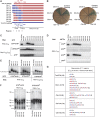Mechanism for the definition of elongation and termination by the class II CCA-adding enzyme
- PMID: 19745807
- PMCID: PMC2776095
- DOI: 10.1038/emboj.2009.260
Mechanism for the definition of elongation and termination by the class II CCA-adding enzyme
Abstract
The CCA-adding enzyme synthesizes the CCA sequence at the 3' end of tRNA without a nucleic acid template. The crystal structures of class II Thermotoga maritima CCA-adding enzyme and its complexes with CTP or ATP were determined. The structure-based replacement of both the catalytic heads and nucleobase-interacting neck domains of the phylogenetically closely related Aquifex aeolicus A-adding enzyme by the corresponding domains of the T. maritima CCA-adding enzyme allowed the A-adding enzyme to add CCA in vivo and in vitro. However, the replacement of only the catalytic head domain did not allow the A-adding enzyme to add CCA, and the enzyme exhibited (A, C)-adding activity. We identified the region in the neck domain that prevents (A, C)-adding activity and defines the number of nucleotide incorporations and the specificity for correct CCA addition. We also identified the region in the head domain that defines the terminal A addition after CC addition. The results collectively suggest that, in the class II CCA-adding enzyme, the head and neck domains collaboratively and dynamically define the number of nucleotide additions and the specificity of nucleotide selection.
Conflict of interest statement
The authors declare that they have no conflict of interest.
Figures







Similar articles
-
Measurement of Acceptor-TΨC Helix Length of tRNA for Terminal A76-Addition by A-Adding Enzyme.Structure. 2015 May 5;23(5):830-842. doi: 10.1016/j.str.2015.03.013. Epub 2015 Apr 23. Structure. 2015. PMID: 25914059
-
Collaboration between CC- and A-adding enzymes to build and repair the 3'-terminal CCA of tRNA in Aquifex aeolicus.Science. 2001 Nov 9;294(5545):1334-6. doi: 10.1126/science.1063816. Science. 2001. PMID: 11701927
-
Divergent evolutions of trinucleotide polymerization revealed by an archaeal CCA-adding enzyme structure.EMBO J. 2003 Nov 3;22(21):5918-27. doi: 10.1093/emboj/cdg563. EMBO J. 2003. PMID: 14592988 Free PMC article.
-
tRNA maturation: RNA polymerization without a nucleic acid template.Curr Biol. 2004 Oct 26;14(20):R883-5. doi: 10.1016/j.cub.2004.09.069. Curr Biol. 2004. PMID: 15498478 Review.
-
tRNA nucleotidyltransferases: ancient catalysts with an unusual mechanism of polymerization.Cell Mol Life Sci. 2010 May;67(9):1447-63. doi: 10.1007/s00018-010-0271-4. Epub 2010 Feb 14. Cell Mol Life Sci. 2010. PMID: 20155482 Free PMC article. Review.
Cited by
-
Function and Regulation of Human Terminal Uridylyltransferases.Front Genet. 2018 Nov 12;9:538. doi: 10.3389/fgene.2018.00538. eCollection 2018. Front Genet. 2018. PMID: 30483311 Free PMC article. Review.
-
Unusual evolution of a catalytic core element in CCA-adding enzymes.Nucleic Acids Res. 2010 Jul;38(13):4436-47. doi: 10.1093/nar/gkq176. Epub 2010 Mar 25. Nucleic Acids Res. 2010. PMID: 20348137 Free PMC article.
-
Structural and functional characterization of multiple myeloma associated cytoplasmic poly(A) polymerase FAM46C.Cancer Commun (Lond). 2021 Jul;41(7):615-630. doi: 10.1002/cac2.12163. Epub 2021 May 28. Cancer Commun (Lond). 2021. PMID: 34048638 Free PMC article.
-
Structural and Evolutionary Analysis of Proteins Endowed with a Nucleotidyltransferase, or Non-canonical Palm, Catalytic Domain.J Mol Evol. 2024 Dec;92(6):799-814. doi: 10.1007/s00239-024-10207-7. Epub 2024 Sep 19. J Mol Evol. 2024. PMID: 39297932 Free PMC article.
-
Dual expression of CCA-adding enzyme and RNase T in Escherichia coli generates a distinct cca growth phenotype with diverse applications.Nucleic Acids Res. 2019 Apr 23;47(7):3631-3639. doi: 10.1093/nar/gkz133. Nucleic Acids Res. 2019. PMID: 30828718 Free PMC article.
References
-
- Adams PD, Grosse-Kunstleve RW, Hung LW, Ioerger TR, McCoy AJ, Moriarty NW, Read RJ, Sacchettini JC, Sauter NK, Terwilliger TC (2002) PHENIX: building new soft warefor automated crystallographic structure determination. Acta Crystallogr D Biol Crystallogr 58: 1948–1954 - PubMed
-
- Augustin MA, Reichert AS, Betat H, Huber R, Mörl M, Steegborn C (2003) Crystal structure of the human CCA-adding enzyme: insights into template-independent polymerization. J Mol Biol 328: 985–994 - PubMed
-
- Brunger AT, Adams PD, Clore GM, DeLano WL, Gros P, Grosse-Kunstleve RW, Jiang JS, Kuszewski J, Nilges M, Pannu NS, Read RJ, Rice LM, Simonson T, Warren GL (1998) Crystallography and NMR system: a new software suite for macromolecular structure determination. Acta Crystallogr D 54: 905–921 - PubMed
-
- Cho HD, Verlinde CL, Weiner AM (2005) Archaeal CCA-adding enzymes: central role of a highly conserved beta-turn motif in RNA polymerization without translocation. J Biol Chem 280: 9555–9566 - PubMed
Publication types
MeSH terms
Substances
Associated data
- Actions
- Actions
- Actions
- Actions
LinkOut - more resources
Full Text Sources

